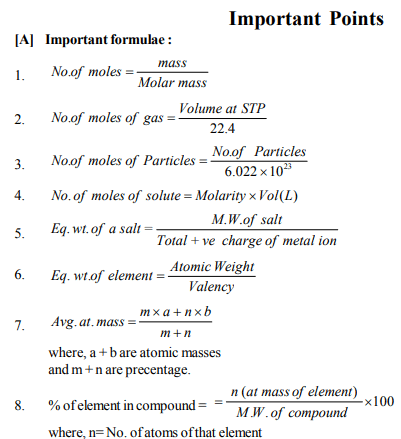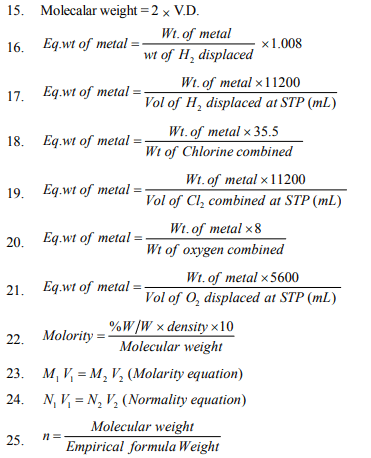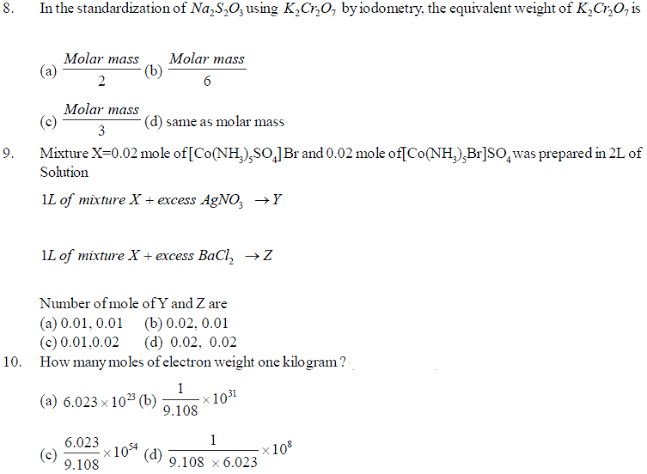- Products formed when Nitrobenzene reacts with HNO3/H2SO4 at 80-100°C
A. 1, 4-Dinitrobenzene
B. 1, 2, 4-Trinitrobenzene
C. 1, 2-Dinitrobenzene
D. 1, 3-Dinitrobenzene
Answer: (d)
- Benzene forms Nitrobenzene on reaction with conc. HNO3/H2SO4, in the reaction HNO3 acts as a
A. catalyst
B. reducing agent
C. base
D. acid
Answer: (c)
- The bad-smelling substance formed by the action of alcoholic caustic potash on chloroform and aniline is
A. Phenyl Isocyanide
B. Nitrobenzene
C. Chloropicrin
D. Acetylene
Answer: (a)
- Which of the following compound will form secondary amine on reaction with LiAlH4?
A. Methyl cyanide
B. Methyl isocyanide
C. Acetamide
D. Nitroethane
Answer: (b)
- Find the compound which is more basic than aniline
A. Diphenylamine
B. Triphenylamine
C. Benzylamine
D. p-Nitroaniline
Answer: (c)
- Chloramine-T is an
A. disinfectant
B. antiseptic
C. analgesic
D. antipyretic
Answer: (a)
- Benzalkonium chloride is a
A. cationic surfactant and antiseptic
B. anionic surfactant and soluble in most of the organic solvents
C. cationic surfactant and insoluble in most organic solvents.
D. cationic surfactant and antimalarial
Answer: (a)
- Interferon is connected with
A. tonic
B. virus
C. carbohydrate
D. ore of iron
Answer: (b)
- Ibuprofen contains
A. only S-enantiomer
B. only R-enantiomer
C. the racemic mixture of both R and S enantiomer
D. both R and S enantiomers are active pain killers
Answer: (c)
- Which of the following is a hypnotic drug?
A. luminal
B. salol
C. catechol
D. chemisol
Answer: (a)
- Detergents are prepared by the action of H2SO4 on which of the following?
A. cholesterol
B. Lauryl alcohol
C. Cyclohexanol
D. p-Nitrophenol
Answer: (b)
- Which of the following will not act as an antacid?
A. sodium hydrogen carbonate
B. magnesium hydroxide
C. sodium carbonate
D. aluminium carbonate
Answer: (c)
- The main cause of acidity in the stomach is
A. release of extra gastric acids which decrease the pH level
B. indigestion and pain in the large intestine
C. increase the pH level in the stomach
D. release of extra bile juice which increases alkaline medium in the stomach
Answer: (a)
- Chloramphenicol is
A. broad spectrum antibacterial
B. broad spectrum analgesic
C. broad spectrum antibiotic
D. narrow spectrum antibiotic
Answer: (c)
- One of the most widely used drugs in medicine iodex is
A. methyl salicylate
B. ethyl salicylate
C. acetyl salicylic acid
D. o-hydroxy benzoic acid
Answer: (a)
- Which one of the following is an example of adsorption?
A. ammonia in contact with water
B.anhydrous CaCl2 with water
C. silica gel in contact with water vapours
D. all of these
Answer: (c)
- At 15oC out of H2, CH4, CO2, NH3, which gas will be adsorbed maximum by charcoal?
A. H2
B. CH4
C. CO2
D. NH3
Answer: (d)
- Which of the following colloids are solvent hating?
A. lyophilic
B. lyophobic
C. hydrophilic
D.none of these
Answer: (b)
- If the dispersed phase is a liquid and the dispersion medium is solid, the colloid is known as
A. foam
B. sol
C. emulsion
D. gel
Answer: (d)
- The process of separating a crystalloid, from a colloid by filtration is called
A. emulsification
B. dialysis
C. coagulation
D. Peptization
Answer: (b)
- The movement of colloidal particles towards the oppositely charged electrodes on passing electric current is known as
A. Tyndall effect
B. Cataphoresis
C. Brownian movement
D. None of these
Answer: (b)
- An emulsifier is a substance which
A. stabilizes the emulsion
B. coagulates the emulsion
C. retards the dispersion of liquid in liquid
D. causes homogenesis of emulsion
Answer: (a)
3.Homogeneous catalysis does mean
A. Reactants and goods have to be at the same level
B. Catalyst and reactants must be in the same phase
C. The reaction mixture must be formed homogeneously during
D. The reaction mixture distribution must be homogeneous
Answer: (b)
- Which of the following kinds of catalysis can be explained by the adsorption theory?
A. enzyme catalysis
B. homogeneous catalysis
C. acid base catalysis
D. heterogeneous catalysis
Answer: (d)
- The volume of gases H2, CH4, CO2 and NH3 adsorbed by 1 gm charcoal at 293 K can be given in the order?
A. CH4 > CO2 > NH3 > H2
B. CO2 > NH3 > H2 > CH4
C. NH3 > CO2 > H2 > CH4
D. NH3 > CO2 > CH4 > H2
Answer: (d)
- Which of the following products are obtained when Na2CO3 is added to a solution of copper sulphate?
A. Basic copper carbonate , sodium sulphate and CO2
B. Copper hydroxide, sodium sulphate and CO2
C. Copper carbonate, sodium sulphate and CO2
D. Copper carbonate and sodium sulphate
Answer: (d)
2.The pair that has similar atomic radii is
A. Mn and Re
B. Ti and Hf
C. Sc and Ni
D. Mo and W
Answer: (d)
- Silver nitrate produces a black stain on the skin due to
A. being a strong reducing agent
B. its corrosive action
C. formation of complex compound
D. its reduction to metallic silver
Answer: (d)
- According to IUPAC nomenclature sodium nitroprusside dihydrate is named as
A. Sodium pentacyanonitrosylferrate (III)
B. Sodium nitroferrocyanide
C. Sodium nitroferricyanide
D. Sodium pentacyanonitrosylferrate (II)
Answer: (a)
- In Fe(CO)5, the Fe-C bond possesses:
A. ionic character
B. sigma character only
C. pi character
D. both sigma and pi characters
Answer: (d)
- The reaction of tert butyl bromide with sodium methoxide produces mainly
A. isobutane
B. isobutylene
C. tert-butyl methyl ether
D. sodium tert butoxide
Answer: (b)
Detail ;
When the reaction of tert butyl bromide occurs with sodium methoxide, an elimination takes place. This is the E1cB elimination, wherein the Hoffman alkene is major. Then dehydro halogenation takes place. Subsequently, rather than an ether, which is typically the case, an alkene is obtained. This is why, isobutylene is formed.
- Which of the following undergoes nucleophilic substitution exclusively by SN1 mechanism?
A. Benzyl Chloride
B. Ethyl chloride
C. Chlorobenzene
D. Isopropyl chloride
Answer: (a)
- The increasing order of nucleophilicity would be?
A. Cl– < Br– < I–
B. I– < Cl– < Br–
C. Br– < Cl– < F–
D. I– < Br– < Cl–
Answer: (a)
- Which of the following is most reactive towards SN1 reaction?
A. C6H5C(CH3)C6H5Br
B. C8H5CH2Br
C. C6H5CH(C6H5)Br
D. C6H5CH(CH3)Br
Answer: (a)
- CH3CH2CH2Br + NaCN → CH3CH2CH2CN + NaBr, will be fastest in
A. ethanol
B. methanol
C. N, N-dimethylformamide
D. Water
Answer: (c)
- A Grignard reagent may be made by reacting magnesium with
1.Methyl amine
2.Diethyl ether
3.Ethyl iodide
4.Ethyl alcohol
Answer: (3)
- C-Cl bond of chlorobenzene in comparison to C-Cl bond in methyl chloride is
1.Longer and weaker
2.Shorter and weaker
3.Shorter and stronger
4.Longer and stronger
Answer: (3)
- A solution of (+) 2-chloro-2-phenylethane in toluene racemises slowly in the presence of a small amount of SbCl5, due to the formation of
1.carbanion
2.carbene
3.free radical
4.carbocation
Answer: (4)
- The decreasing order of boiling points of alkyl halides is
1.RF > RCl > RBr > RI
2.RBr > RCl > RCl > RF
3.RI > RBr > RCl > RF
4.RCl > RF > RI > RBr
Answer: (3)
- Phosgene is commonly known as
1.thionyl chloride
2.carbonyl chloride
3.carbon dioxide and phosphine
4.phosphoryl chloride
Answer: (2)
- A mixture of benzaldehyde and formaldehyde on heating with aqueous NaOH solution gives
A. benzyl alcohol + sodium formate
B. sodium benzoate + methanol
C. benzyl alcohol + methanol
D. sodium benzoate + sodium formate
Answer: (a)
- Which of the following has the most acidic hydrogen?
A. hexane-2,4-dione
B. hexane-2,3-dione
C. hexane-2,5-dione
D. hexane-3-one
Answer: (a)
- A new C-C bond formation is possible in
A. cannizzaro reaction
B. friedel crafts reaction
C. clemmensen reduction
D. reimer tiemann reaction
Answer: (b,d)
- Under Wolff-Kishner reduction conditions, the conversions which may be brought about are
A. cyclohexanone into cyclohexane
B. benzaldehyde into benzyl alcohol
C. cyclohexanone into cyclohexanol
D. benzophenone into diphenylmethane
Answer: (a,d)
- The formation of cyanohydrin from a ketone is an example of
A. electrophilic addition
B. nucleophilic addition
C. nucleophilic substitution
D. electrophilic substitution
Answer: (b)
- Benzoic acid reacts with conc.HNO3 and conc.H2SO4 to give
A. o-nitrobenzoic acid
B. p-nitrobenzoic acid
C. m-nitrobenzoic acid
D. o,p-dinitrobenzoic acid
Answer: (c)
- An inorganic compound producing an organic compound on heating is
A. ammonium cyanate
B. soda lime
C. sodamide
D. potassium cyanide
Answer: (a)
- The reaction of ethyl formate with an excess of CH3MgI followed by hydrolysis gives
A. ethanol
B. n-propyl alcohol
C. propanal
D. isopropyl alcohol
Answer: (d)
- Formic acid and acetic acid are distinguished by reaction with
A. sodium ethoxide
B.sodium
C. HgCl2
D. 2,4-dinitrophenylhydrazine
Answer: (c)
- Heating a mixture of sodium benzoate and soda lime gives
A. calcium benzoate
B. benzene
C. sodium benzoate
D. methane
Answer: (b)
- The mole fraction of the solute in one molal aqueous solution is
A. 0.009
B. 0.018
C. 0.027
D. 0.036
Answer: (b)
- 5 cm3 of acetone is added to 100 cm3 of water, the vapour pressure of water over the solution will be
A. equal to the vapour pressure of pure water.
B. less than the vapour pressure of pure water.
C. greater than the vapour pressure of pure water.
D. very large.
Answer: (b)
- The density of a solution prepared by dissolving 129g of urea in 1000g of water is 1.15g/ml. The molarity of this solution is
A. 1.78M
B. 1.02M
C. 2.05M
D. 0.50M
Answer: (c)
- If at a certain temperature the vapour pressure of pure water is 25 mm Hg and that of a very dilute aqueous urea solution is 24.5 mm Hg, the molality of the solution is:
A. 0.02
B. 1.2
C. 1.11
D. 0.08
Answer: (c)
- The relationship between osmotic pressure at 273K when 10g glucose (P1), 10g urea (P2) and 10g sucrose (P3) are dissolved in 250ml of water is
A. P1 > P2 > P3
B. > P1 > P2
C. P2 > P1 > P3
D. P2 > P3 > P1
Answer: (c)
1 Like
- Two liquids X and Y form an ideal solution. At 300K vapour pressure of the solution containing 1mol of X and 3 mol of Y is 550 mm Hg. At the same temperature, if 1 mol of Y is further added to this solution, the vapour pressure of the solution increases by 10 mm Hg. Vapour pressure of X and Y in the pure states will be respectively
A. 300 and 400
B. 400 and 600
C. 500 and 600
D. 200 and 300
Answer: (b)
- Mixing up equal volumes of 0.1M NaOH and 0.1M CH3COOH yields a solution which is
A. basic
B.acidic
C. neutral
D. None
Answer: (a)
- Equal volumes of 0.1M AgNO3 and 0.2M NaCl are mixed. The concentration of NO3– ions in the mixture will be
A. 0.1M
B. 0.05M
C. 0.2M
D. 0.15M
Answer: (b)
- Which of the following should be done in order to prepare 0.4M NaCl starting with 100ml of 0.3M NaCl?
A. add 5.85g of NaCl
B. and 20ml water
C. add 0.01 mol NaCl
D. evaporate 10ml of water
Answer: (c)
- The volume of 0.025M H3PO4 required to neutralise 25ml of 0.03M Ca(OH)2 is
A. 20ml
B. 25ml
C. 40ml
D. 50ml
Answer: (a)
- Photochemical smog normally does not contain
(a) Chlorofluorocarbons
(b) Peroxyacetyl nitrate
(c) Ozone
(d) Acrolein
Answer: (a)
- Depletion of the ozone layer is caused due to
(a) Ferrocene
(b) Fullerenes
(c) Freons
(d) Polyhalogens
Answer: (c)
- Find the incorrect statement
(a) BOD value of clean water is less than 5 ppm
(b) Drinking water pH should be between 5.5-9.5
(c) carbon, sulphur and nitrogen oxides are the most widespread air pollutants
(d) dissolved oxygen concentration below 5 ppm is ideal for the growth of fish
Answer: (d)
- Find the secondary pollutant among these
(a) PAN
(b) N2O
(c) SO2
(d) CO2
Answer: (a)
- The reaction responsible for the radiant energy of the Sun is
(a) nuclear fission
(b) nuclear fusion
(c) chemical reaction
(d) combustion
Answer: (b)
- Alum’s capacity to purify water is due to
(a) softens hard water
(b) pathogenic bacteria get destroyed
(c) impurities’ coagulation
(d) it improves taste
Answer: (c)
- The coldest region of the atmosphere
(a) Troposphere
(b) Thermosphere
(c) Stratosphere
(d) Mesosphere
Answer: (d)
- Which of the oxide of nitrogen is not a common pollutant?
(a) N2O5
(b) N2O
(c) NO
(d) NO2
Answer: (a)
- The compound essential for the process of photosynthesis has this element
(a) Ca
(b) Ba
(c) Fe
(d) Mg
Answer: (d)
- In the air, N2 and O2 occur naturally but they do not react to form oxides of nitrogen because
(a) oxides of nitrogen are unstable
(b) catalyst is required for the reaction
(c) the reaction is endothermic
(d) N2 and O2 do not react with each other
Answer: (c)
- This about carbon monoxide is incorrect.
(a) It is produced due to incomplete combustion
(b) The carboxyhaemoglobin (haemoglobin found to CO) is less stable than oxyhaemoglobin
(c) It reduces the oxygen-carrying ability of blood
(d) It forms carboxyhaemoglobin
Answer: (b)
- This is a sink for CO
(a) Haemoglobin
(b) Oceans
(c) Micro organisms present in the soil
(d) Plants
Answer: (c)
- DDT is
(a) Nitrogen containing insecticide
(b) Biodegradable pollutant
(c) Non-Biodegradable pollutant
(d) An antibiotic
Answer: (c)
- Which of the following techniques is/are used in controlling water pollution?
(a) Reverse osmosis
(b) Ion exchange process
(c) Adsorption process
(d) All of these
Answer: (d)
- Which of the following pollutants cannot be degraded by natural process?
(a) Heavy metals
(b) DDT
(c) Nuclear waste
(d) All of these
Answer: (d)
1 Like
- Which is the best-suited method for the separation of para and ortho-nitrophenols from 1:1 mixture?
(a) crystallisation
(b) chromatography
(c) sublimation
(d) steam distillation
Answer: (d)
- Find the incorrect statement for a nucleophile
(a) A nucleophile is a Lewis acid
(b) Nucleophiles do not seek electron
(c) Ammonia is a nucleophile
(d) Nucleophiles attack low electron density sites
Answer: (a)
- Which among the following is the most deactivating meta-directing group in aromatic substitution reaction?
(a) -COOH
(b) -SO3H
(c) -NO2
(d) -CN
Answer: (c)
- Ammonia evolved from 0.75 g of the soil sample in the Kjeldahl’s method for nitrogen estimation, neutralises 10 ml of 1M H2SO4. Find the percentage of nitrogen present in the soil
(a) 35.33
(b) 37.33
(c) 43.33
(d) 45.33
Answer: (b)
- The correct order of increasing nucleophilicity is
(a) Cl– < Br– < I–
(b) Br– < Cl– < I–
(c) I– < Br– < Cl–
(d) I– < Cl– < Br–
Answer: (a)
1 Like


